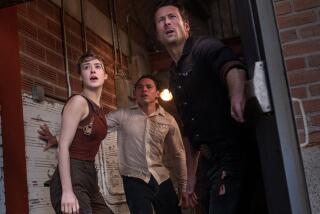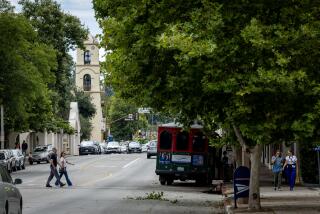Christo’s Staff Stunned, Grasping for Answers : Tragedy: Project headquarters, usually a scene of bustling activity, was eerily quiet Sunday as downcast workers tried to figure out what went wrong.
- Share via
LEBEC — Downcast Christo project workers on Sunday grasped for answers to the nightmare question: How did a 488-pound umbrella assembly from their giant art installation break loose from its moorings and become a deadly, wind-propelled projectile?
“It had been such a wonderful, successful project,” Augie Huber, general contractor of Christo’s “The Umbrellas: Joint Project for Japan and U.S.A.” said Sunday at project headquarters.
“If only the wind had come six hours later, there would have been no people up there.”
The conference room where he sat, dominated by a giant topographic map that showed with pushpins the location of all 3,100 umbrellas in the bi-continental project, ordinarily bustled with activity. But on this morning, all frivolity was absent.
Staffers moved quietly, sometimes interrupting their work to discuss the tragedy and piece together just what had gone wrong.
“You know, my son was out there on the mountain at the same time,” Huber said, clearly shaken. “I keep thinking about that.”
Huber had been working on the project for almost four years, and was intimately familiar with the structural anatomy of the umbrellas.
The methods used to secure them to the ground varied with the composition of the terrain, he explained. Some in Japan were specially rigged to stand in the middle of a river. Some along highways in the United States required a concrete base.
But the vast majority of the aluminum and fabric umbrellas, including the one that struck Lori Keevil-Mathews on Saturday, were held to the surface by a system of steel components.
In each steel base, a set of heavy crossbeams were held in place by four screw anchor rods that went about 40 inches into the ground. Attached to each beam was a leveling plate and sleeve that held the umbrella upright.
On Saturday, an unexpected, violent wind caused the system on one umbrella to fail, crushing Camarillo resident Keevil-Mathews, 34, against a boulder.
“An updraft pulled it right out of the ground,” said Vince Davenport, director of field operations. Two of the screw anchors became so loose, he said, that the umbrella fell on its side. “The other two snapped and the umbrella just took off.”
The wind had been one of the factors most carefully considered in the design and engineering of the giant umbrellas, Huber said. Christo often spoke of how he envisioned the luminescent fabric billowing in the breeze, and how it was to his environmental art project.
The artist bought expensive testing-time last year at the wind tunnel of the National Research Council of Canada in Ottawa. The tests showed that umbrella prototypes could withstand winds up to 65 m.p.h. when open and 110 m.p.h. when closed.
This was thought to be within acceptable limits because in October the typhoon season was usually over in Japan and the windy Tejon Pass was at just about its calmest.
But almost from the beginning, the environmental artist had trouble with the environment. A late offshore typhoon blew down three umbrellas in Japan only hours after they had been opened. On Oct. 20, many of the umbrellas in California were closed to prevent the same fate.
“The real problem is the wind gusts,” said Huber, noting that the turbulent, swirling gusts that tore down the umbrellas in Japan can occur even when prevailing winds are well within acceptable limits.
Tom Golden, project director in California, had said in an earlier interview that for this reason, Christo had declared that whenever the sustaining winds hit 35 m.p.h., the umbrellas should be closed. “They just gyrate too much,” he said.
Golden was with Christo in Japan on Saturday when the tragedy struck.
Saturday morning and early afternoon were cloudy in the Tejon Pass and moderately windy, Huber said, but not threatening. “It was blowing at 10, 20 m.p.h.,” he said, and mostly out of the south.
The forecasts, which he said were obtained from a private weather service that he declined to identify, were foreboding but did not warn of immediate danger. “They called for winds gusting up to 40, 45 m.p.h beginning at midnight,” Huber said.
The first hint of real trouble, he said, came at about 4:10 p.m. when there was a report that a wind gust had toppled an umbrella on a hill above Lebec. Huber said he then ordered staff monitors to begin warning visitors to stand clear of the umbrellas.
Workers also began to crank down umbrellas near major roads.
At 4:55 p.m., a call came from Kern County Sheriff’s Sgt. Fred Skidmore. “I had gotten information that there was a storm in Bakersfield heading our way,” Skidmore said. “It had come up fast and we had reports it had taken down power lines.”
It was a freak storm whose winds seemed greater than 65 m.p.h., said Skidmore, stationed in the area for three years.
“It is unusual to have a storm come up from that direction with a bang like that,” he said. Huber went outside and saw the storm coming from the north. What he saw made him shiver, even in the retelling.
“It was like a black wall, like nothing I had ever seen in my life,” he said. “And it was moving so fast it was unbelievable.”
“It came up in a matter of seconds,” said Ann Sterling of Bakersfield, who was working as a monitor on Saturday. “Suddenly it felt like we had been hit by a tornado. We ran for our cars.”
For the rest of Sunday, Christo staffers somberly organized the closing.
Some still wanted to visit. Chris Pennella, Golden’s assistant, finally told one caller, “There really is not much reason to come up here.
“This is no longer a work of art.”
Umbrella Tragedy
Lori Keevil-Mathews, 34, was killed when a Christo umbrella broke loose in high winds Saturday. Most of the umbrellas are held by four steel, 40-inch long anchors screwed into the ground.
1. A storm over the Tejon Pass area caused strong winds to gust and swirl, exerting tremendous pressures on the 28-foot diameter umbrella. (Scale of umbrella in comparison to a person)
2. Two anchors were pulled from the ground by a big gust, then the two other anchors sheared off at ground level as the umbrella toppled, project officials said. The over 500-pound assembly was blown along the ground and struck Keevil-Mathews. (Leveling Plate, Molded polymer cover, Screw anchors)
More to Read
Sign up for Essential California
The most important California stories and recommendations in your inbox every morning.
You may occasionally receive promotional content from the Los Angeles Times.














